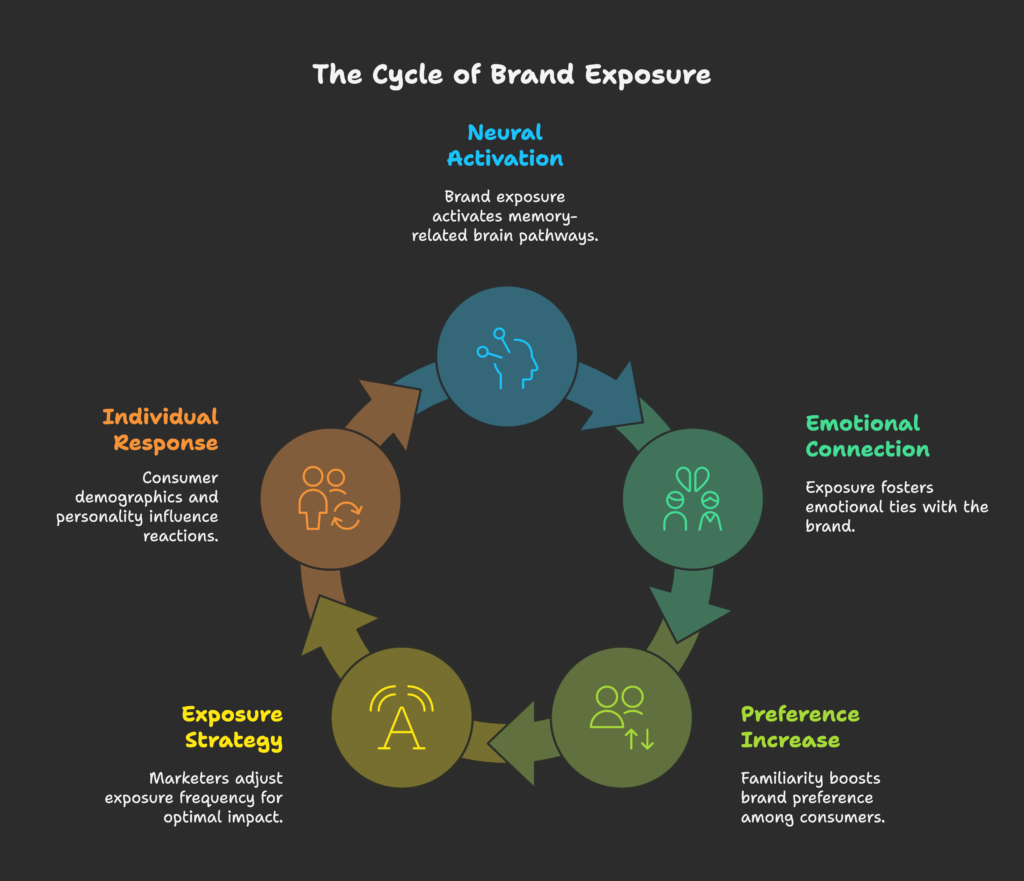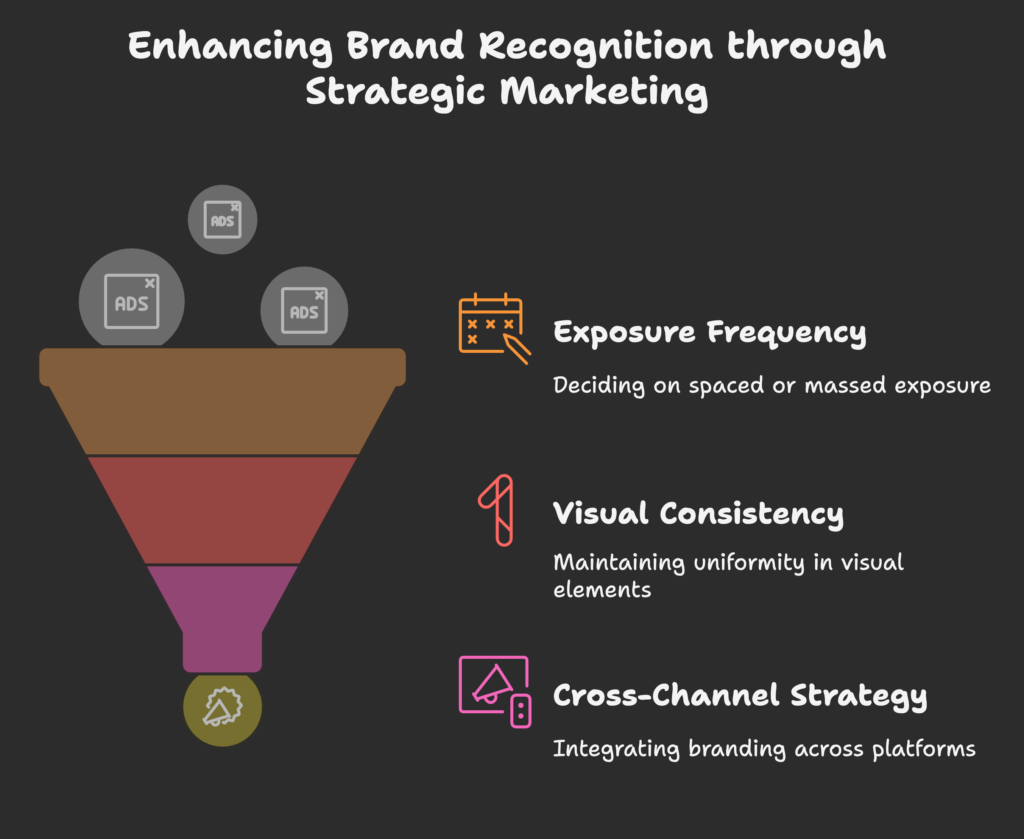Have you ever found yourself humming a jingle you barely liked at first? Or perhaps you noticed a brand logo repeatedly and started feeling more comfortable with it, even if you never planned to buy its products? That magical shift could be due to the mere exposure effect—the simple idea that we grow fond of something just because we encounter it often. Curious to learn how this subtle psychological phenomenon can transform your brand recognition strategy? By the time you finish reading, you will discover how repeated exposure can make potential customers choose you over your competitors. Ready to begin? Let’s dive in!
Introduction to the Mere Exposure Effect
In this section, you will learn what the mere exposure effect is, how it developed historically, and why it matters for your business. By the end, you’ll see why familiarity can be a game-changer for brand success. Let’s unpack its core ideas!
Definition and Conceptual Framework
The mere exposure effect is the tendency to like something more simply because we see or experience it often. Back in 1968, the psychologist Robert Zajonc highlighted that repeated contact with an object or idea increases positive feelings toward it. Over time, our brains find comfort in familiarity, leading us to form a preference.
This concept holds powerful value for businesses. When customers repeatedly see a brand, they grow comfortable and even develop positive associations without deep conscious analysis. That’s why familiar logos, taglines, and jingles stick in our minds.
Now that you understand the basic definition, are you ready to see what’s happening beneath the surface? Let’s check out the psychology behind mere exposure.
The Psychology Behind Mere Exposure
In this part, we explore why mere exposure works so well. You will see how our brains link frequent encounters with feelings of trust and safety. By the end, you’ll discover how this helps build deeper connections with customers.
Mere exposure often works on a subconscious level. Our minds process repeated stimuli faster and interpret them as less threatening. From an evolutionary standpoint, “safe” often means “familiar.” When your brand’s visuals or messages appear often, people start to trust them and feel more comfortable engaging.
Ready to see the bigger business benefit in action? Let’s find out why this effect is so important in brand strategy.
The Business Case for Mere Exposure Strategies
Here, you’ll learn how repeated exposure can shape your competitive advantage, save marketing costs, and build long-term brand equity. By the end, you’ll be convinced that incorporating mere exposure is not just a nice idea—it’s essential.
Repetitive visibility increases brand recall and helps you stand out from crowded markets. Research shows that people are more likely to pick a brand they recognize over an unfamiliar one, even if the product details are the same. It’s also a cost-effective method because you’re focusing on consistent messaging rather than chasing complicated campaigns.
Curious about how our brains actually respond to brand familiarity? Let’s move on to the deeper neurological and psychological foundations.
Neurological and Psychological Foundations
In this section, we’ll look at how repeated exposure affects our brains and emotions. You’ll also discover the idea of the inverted U-shaped curve and learn how individual differences shape our response to familiarity. Let’s see what’s happening inside our heads!

Brain Mechanisms in Familiarity Processing
In this part, you will learn about the brain areas responsible for recognizing repeated stimuli and forming emotional connections. By the end, you’ll understand why repeated exposure can create lasting brand impressions.
Frequent encounters with a specific brand activate neural pathways related to memory and recognition. Regions like the amygdala play a role in processing emotions—so if a brand’s repeated message sparks positive feelings, it’s more likely to stick. Over time, these neural circuits become faster at responding to that brand, giving you a powerful edge.
Now that we’ve seen how the brain supports familiarity, let’s explore the sweet spot of exposure frequency.
The Inverted U-Shaped Response Curve
Here, we will discuss how a certain level of repeated exposure can boost liking and when too much can become overwhelming. By the end, you’ll see why balance is crucial.
When people first see your brand, each additional exposure can increase preference—up to a point. This is the peak of the inverted U curve. Beyond that, too much repetition can cause boredom or irritation. Smart marketers strive to find the best frequency that keeps familiarity positive without becoming annoying.
Next, we’ll look at why individuals may respond differently to the very same exposure strategies.
Individual Differences in Mere Exposure Response
In this segment, you will learn how demographics, personality, and cultural background can change how people react to repeated brand messages. By the end, you’ll understand the importance of tailoring your approach.
Some groups enjoy seeing the same familiar logo over and over, while others crave variety. Culture also plays a role: certain societies may love persistent ads, while others may dislike them quickly. Knowing your audience helps you craft an exposure strategy that resonates most effectively.
Ready to turn this knowledge into real-world marketing tactics? Let’s move on to strategic implementation.
Strategic Implementation in Marketing
In this section, you’ll find out how to decide on exposure frequency, design consistent visuals, and coordinate campaigns across different channels. By the end, you’ll see practical steps to make mere exposure work for you.

Exposure Frequency and Timing Strategies
This part looks at how often and when you should expose your audience to brand messages. By the end, you’ll know the difference between spaced repetition and massed exposure, and why it matters.
Spaced repetition means showing your ads or messages at intervals, allowing people to process each encounter. Massed exposure involves showing them many times in a short period. Both can work, but the key is testing which approach fits your product and audience. Also, try to coordinate messaging across different times of the day or week to keep interest high.
Once you’ve nailed your timing, let’s see how a consistent visual identity can multiply these benefits.
Visual Identity and Consistency
Here, you’ll learn why consistent colors, logos, and typography are vital for building brand familiarity. By the end, you’ll see how clear visuals help people remember your brand more easily.
A stable visual identity gives your audience a “cue” that reminds them of who you are. If your logo appears with the same design elements—like color schemes or fonts—people immediately connect these features with your company. This consistency ensures that each new exposure strengthens brand memory.
Ready to spread that identity across multiple platforms? Let’s explore cross-channel strategies next.
Cross-Channel Implementation Strategies
In this final part of the marketing section, you will discover how to show consistent branding everywhere, from digital ads to in-store displays. By the end, you’ll see the power of integrated marketing.
Your customers might see your brand on social media, hear about you on a podcast, or spot you on a billboard. If your colors, messaging, and overall “feel” are united, each encounter adds another layer of familiarity. Track your efforts with analytics to see which channels yield the best results, then keep refining your strategy.
Now, let’s move to the digital side of things and see how mere exposure thrives online.
Digital Applications of the Mere Exposure Effect
This section focuses on how to apply mere exposure in social media, digital advertising, and website design. By the end, you’ll be ready to capitalize on every online touchpoint.
Social Media Strategies
First, we’ll talk about using platforms like Facebook, Instagram, or TikTok to maintain a steady presence. By the end, you’ll know how to schedule content so that followers grow familiar with your brand without feeling bombarded.
Creating a content calendar ensures your posts show up consistently. Simple tactics—like using similar styles in images or repeating key hashtags—can reinforce brand familiarity. Pay attention to how algorithms prioritize fresh engagement. Mixing up your formats (images, short videos, stories) can keep your brand interesting while still feeling familiar.
Next, let’s see how digital ads and retargeting can strengthen those positive associations.
Digital Advertising and Retargeting
Here, you’ll learn about showing ads repeatedly to users who have already visited your site or interacted with your content. By the end, you’ll see how this approach can help turn casual browsers into buyers.
Retargeting campaigns remind interested users of your brand just enough to keep it top-of-mind. Programmatic advertising can also spread your message across various websites, ensuring repeated exposure. However, remember the inverted U-curve—avoid blasting the same ads too often. A well-balanced strategy keeps people engaged without feeling overwhelmed.
Now that your ads are out there, how can your website itself build on that familiarity? Let’s explore.
Website and User Experience Design
In this section, you’ll discover how consistent branding, site navigation, and micro-interactions can reinforce brand recognition. By the end, you’ll see how every click can deepen positive impressions.
Keeping your brand visuals uniform on your homepage, product pages, and checkout builds trust. Simple navigation and thoughtful design show visitors you care about their experience. Even small animations or icons can remind them they’re still interacting with your brand.
Next, we’ll turn our attention to traditional media. Yes, mere exposure is powerful offline too!
Traditional Media Applications
Here, we discuss how to use print, broadcast, and environmental advertising for repeated brand encounters. By the end, you’ll see that mere exposure isn’t just for the digital world.
Print Advertising Strategies
This part covers how often to place ads in magazines or newspapers and how to maintain visual consistency. By the end, you’ll see how print can still capture attention in a digital age.
Repeated print ads, with the same color scheme and headline style, stay in readers’ memories. Including a consistent tagline or call-to-action also helps. Regular appearances in relevant publications keep your brand’s name and look fresh in people’s minds.
Ready to hit the airwaves? Let’s look at broadcast approaches.
Broadcast Media Approaches
Next, we’ll talk about how TV and radio can reinforce brand familiarity through repeated messages. By the end, you’ll understand the power of sound and visuals together.
Short, memorable jingles or catchphrases can embed your brand in listeners’ memories. On TV, show your logo clearly and consistently. Over time, these broadcast touchpoints become part of daily life for viewers and listeners, turning your brand into something they recognize instantly.
Now, let’s see how physical environments can also bolster repeated exposure.
Environmental and Experiential Exposure
Here, you’ll learn how retail spaces, events, and out-of-home ads can create repeated brand encounters in the real world. By the end, you’ll see how to extend familiarity beyond screens and pages.
Think about billboard placements on busy roads or consistent signage in your store. Sponsoring local events can also put your logo in front of attendees multiple times. The more touchpoints you have, the more ingrained your brand becomes in daily life.
Next, we’ll talk about measuring whether all these repeated efforts are paying off.
Measuring the Impact of Mere Exposure
In this section, you’ll discover how to track brand recognition, analyze conversion behavior, and use advanced methods to prove the true value of repeated exposure. By the end, you’ll be ready to link familiarity to real results.
Brand Recognition Metrics
Here, we’ll talk about ways to measure whether people recognize and recall your brand. By the end, you’ll know some straightforward metrics to see if mere exposure works.
You can use unaided recall tests—where people name brands from memory—or aided recall, which checks if they recognize your brand from a list. Timing how quickly they identify your logo can also provide insight into how strongly familiarity has taken root.
Next, let’s connect these recognition metrics to behavior, which is ultimately what drives sales.
Conversion and Behavior Impact Analysis
In this part, you’ll learn how repeated exposure can nudge people to buy or sign up. By the end, you’ll see how to link frequency to sales data.
Track how often someone sees your brand before they become a paying customer. You may find that a certain number of exposures correlates with higher conversion rates. Also, check if your brand ends up in customers’ “consideration set,” meaning they think of you when they’re ready to purchase.
Once you understand this link, you might want to dive deeper. Let’s look at advanced ways to measure mere exposure.
Advanced Measurement Methodologies
Here, we’ll explore tools like neurological tracking, eye-tracking, and implicit tests to measure brand familiarity. By the end, you’ll see how to gain deeper insights into your audience’s minds.
Brain scans or eye-tracking can show you exactly how people respond to repeated brand elements. Implicit association tests uncover subconscious preferences. These methods help confirm whether exposure is not only noticed but also forming positive brand feelings.
Ready for real-life success stories? Let’s move on to case studies.
Case Studies and Success Stories
In this section, you’ll discover examples of big brands, digital giants, and small businesses that effectively used mere exposure. By the end, you’ll see how businesses of all sizes can make it work.
Consumer Product Brand Examples
Here, we’ll look at Coca-Cola, Nike, Apple, and McDonald’s to learn how constant repetition shaped their market presence. By the end, you’ll see patterns you can apply yourself.
Coca-Cola’s logo and bright red design are recognizable around the world due to consistent, near-constant exposure. Nike’s swoosh rarely changes—its simple shape and repeated appearance on shoes, ads, and clothing burn it into memory. Apple’s sleek product designs and minimalistic marketing keep everything familiar, while McDonald’s uses logos, jingles, and iconic colors to reinforce brand identity daily.
Next up: brands that started or thrive primarily online. Let’s see what the digital masters do.
Digital Brand Success Stories
Now, we focus on how companies like Facebook, Google, Amazon, and Netflix harness mere exposure in the digital space. By the end, you’ll understand online strategies to boost familiarity.
Facebook updates its interface subtly but keeps certain branding elements the same, ensuring recognition even as it evolves. Google’s homepage is famously simple, yet the colorful letters remain unchanged, helping users feel at home instantly. Amazon strategically places its logo on every corner of its site, and Netflix integrates its brand into its content interface, so you always know whose platform you’re enjoying.
But what if you’re not a big name yet? Let’s see how small businesses handle this.
Small Business and Emerging Brand Applications
Finally, we’ll explore how smaller budgets can use mere exposure tactics to break into the market. By the end, you’ll see that creativity and consistency can go a long way.
Local stores can saturate their neighborhood with consistent signage. Emerging online brands can use affordable digital ads and social media schedules to show up regularly in front of a niche audience. Even small gestures like stickers or community sponsorships can foster the same sense of familiarity bigger brands rely on.
Of course, every strategy has its pitfalls. Let’s move on to potential challenges and how to handle them.
Potential Pitfalls and Limitations
In this section, you’ll learn about overexposure, ethical concerns, and how to keep your brand distinct in a crowded space. By the end, you’ll know what to avoid and how to handle tough situations.
Overexposure Risks and Mitigation
Here, we’ll talk about the danger of annoying your audience with too much repetition. By the end, you’ll see how to balance exposure carefully.
Too many ads can feel spammy, causing negative associations. Mitigate this risk by rotating creative content or timing your messages so they don’t pop up incessantly. If you sense audience fatigue, pause or adjust your campaign to give them a break.
Now that you know not to overwhelm them, let’s consider the ethics of using mere exposure.
Ethical Considerations in Mere Exposure Strategies
This part explores how to use repeated exposure without misleading or manipulating. By the end, you’ll see how to maintain trust while still achieving brand presence.
Be transparent about your advertising tactics. Make sure you’re offering value, not just intruding on people’s attention. Ethical usage of mere exposure builds genuine, lasting trust because your audience sees you as honest, not pushy.
But what if your competition is also vying for the same eyeballs? Let’s talk about differentiation next.
Competitive Considerations and Differentiation
Finally, we look at how to stand out when others are also fighting for repeated exposure. By the end, you’ll see how to keep your brand unique while staying consistent.
Strong brand assets (like distinctive logos or taglines) are key. Even if many brands flood the same space, well-crafted visuals and messages cut through the noise. Keep evolving carefully, so your brand feels fresh while staying recognizable.
Now let’s look ahead to new frontiers and technologies that will shape the future of mere exposure strategies.
Future Trends and Innovations
In this section, you’ll learn about upcoming technology, personalization, and global considerations that will change how we use repeated exposure. By the end, you’ll be ready to embrace what’s next.
Technological Advancements in Exposure Opportunities
Here, we explore how augmented reality (AR), virtual reality (VR), voice assistants, and AI personalization can create new avenues for brand exposure. By the end, you’ll see the next phase of repeated encounters.
Imagine brand elements integrated into AR or VR experiences, making them part of your daily life in more immersive ways. AI-driven ads can personalize how often and when you see a message, further refining exposure frequency.
From technology to personalization—let’s see how tailoring brand messages can supercharge familiarity.
Personalization and Contextual Relevance
This part discusses how customizing exposure based on user data can strengthen positive reactions. By the end, you’ll see how to make your repeated messages feel fresh and fitting.
People are less likely to tire of seeing a brand if its messages match their interests. Personalization tools can adjust content based on past behavior, location, or even device type. Just remember to respect privacy and avoid being too invasive.
Finally, we shouldn’t forget that different cultures may respond differently to frequent brand exposure. Let’s explore that next.
Cross-Cultural and Global Considerations
In this last segment on future trends, you’ll learn how cultural norms affect the success of mere exposure in various markets. By the end, you’ll know how to adapt globally without losing your brand’s essence.
Some cultures welcome constant brand interaction, while others find it overwhelming or intrusive. Tailor your exposure strategy to local tastes, languages, and customs. Even small adjustments in messaging can make a huge difference in global markets.
Now, let’s put everything together with an implementation guide and best practices.
Implementation Guide and Best Practices
In this final section, you will see how to develop a solid mere exposure plan, integrate it with your overall strategy, and adapt it to different business sizes. By the end, you’ll have a roadmap for success.
Developing a Mere Exposure Strategy
Here, you’ll learn the first steps in identifying your brand’s exposure points and scheduling them properly. By the end, you’ll have a blueprint to guide your efforts.
Start with a simple audit: where does your brand currently appear? Look for gaps or repetitive channels that don’t bring value. Then, craft a plan that maximizes familiarity across high-impact touchpoints. Prioritize consistency—visuals, messaging, and timing should all align.
Next, let’s see how to fit this plan into your broader marketing goals.
Integration with Broader Marketing Strategy
In this part, we’ll discuss aligning mere exposure tactics with other marketing methods. By the end, you’ll see how repeated exposure can support everything from product launches to content marketing.
Connect your exposure plan to core brand messages. For instance, if you’re running a special campaign, incorporate its theme into every channel. Make sure your social media updates, email newsletters, and even offline events echo the same design and tagline. This unity makes every contact with your brand feel like a natural progression.
Finally, let’s talk about practical guidelines for businesses at different stages.
Practical Guidelines for Different Business Types
Here, we’ll look at how large corporations, mid-size companies, and small businesses can tailor mere exposure to their scale. By the end, you’ll know how to apply these principles, no matter your budget.
Large enterprises might run multi-channel campaigns spanning television, digital, and out-of-home. Mid-market companies might focus on a balanced mix of social media and selective offline ads. Small businesses can use local partnerships, targeted social ads, and consistent branding elements. In each scenario, repetition and consistency are the keys to locking in familiarity.
You’ve now explored every corner of the mere exposure effect—from psychological roots to real-world execution.
Final Note: If you run a Shopify store, remember that growing your sales often requires consistent brand exposure too. One tool that can help is Growth Suite. With Growth Suite, you can streamline your marketing efforts, keep your visuals uniform, and optimize how often customers see your brand—turning simple familiarity into loyal patronage.
Thank you for reading, and may your brand shine brighter with every new encounter!




